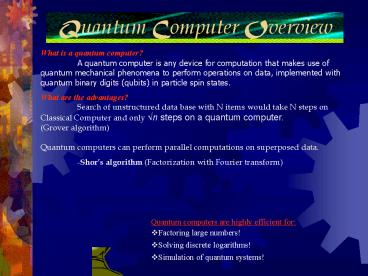Quantum Computer Overview - PowerPoint PPT Presentation
Title:
Quantum Computer Overview
Description:
quantum mechanical phenomena to perform operations on data, ... Five major types and their tautological equivalents: -Inverter (NOT also a quantum primitive) ... – PowerPoint PPT presentation
Number of Views:88
Avg rating:3.0/5.0
Title: Quantum Computer Overview
1
Quantum Computer Overview
What is a quantum computer? A quantum computer
is any device for computation that makes use
of quantum mechanical phenomena to perform
operations on data, implemented with quantum
binary digits (qubits) in particle spin
states. What are the advantages? Search of
unstructured data base with N items would take N
steps on Classical Computer and only vn steps on
a quantum computer. (Grover algorithm) Quantum
computers can perform parallel computations on
superposed data. -Shors algorithm
(Factorization with Fourier transform)
Quantum computers are highly efficient for
- Factoring large numbers!
- Solving discrete logarithms!
- Simulation of quantum systems!
2
Quantum Registers, Ket Notation
Typical state vector of single-particle system
Where a2 ß2 1 and a2 or ß2 give the
probability of observing each state. Since all
possible 2n binary states of an n-qubit quantum
register can be superposed, the register can be
described by a state vector ?gt a0000gt
a1001gt a2010gt a3011gt an?gt or
in a column with 2n entries correlating binary
states to amplitudes.
?1 a10gt ß11gt
Example (With arbitrary amplitudes abi is
v(a2b2))
3
Quantum Array Notation vs. Classical
All quantum circuits are reversible (have a
one-to-one correspondence between input
and output vectors), so quantum array gates do
not have an implicate direction like standard
Boolean gates.
Example (Toffoli EXOR-middle)
4
Quantum Permutative Gates Overview
All quantum gates are represented by unitary
matrices that define transformations on
qubits. Permutative gates are gates whose
unitary matrices are simply permutative
matrices. Five major types and their
tautological equivalents -Inverter (NOT also
a quantum primitive) -Feynman (Controlled-NOT) -To
ffoli (Controlled-Controlled-NOT) -Fredkin
(Controlled-Swap) -Swap These gate-matrices can
also be described by how many inputs are fed to
the output with no transformations, in which case
they are said to be k-through. A reversible
gate with n inputs/outputs is described by a
2n2n matrix.
5
Inverter (NOT)
Schematic (zero-through)
Unitary Matrix
Logic
6
Feynmann (CNOT)
Unitary Matrices
Logic
Schematic (one-through)
EXOR-Down
EXOR-Up
7
Toffoli (CCNOT)
Schematic of EXOR-down (two-through)
Unitary Matrix
Logic
8
Fredkin (CSWAP)
Unitary Matrix
Schematic of Fredkin-Up (one-through)
Logic
9
Swap Gate
Schematic (zero-through)
Feynmann Gate Realizations
Unitary Matrix
Logic
Pb, Qa
10
Universal Controlled Gate
Pa if a0 then Qb if a1 then QU(b)
11
Matrices Overview
Testing for Unitary Matrix U (Example Phase
gate matrix)
-Identity Matrix (Square matrix with 1 in
entries along main diagonal, 0s elsewhere)
1) Take the hermitian transpose U of U
-Permutation Matrix Square matrix with entry of
1 in each row/column
2) Verify that UU I (the corresponding nn
identity matrix)
-Inverse Matrix Square matrix A-1 of A such that
AA-1A-1AIn
-Orthogonal Matrix Square matrix Q whose
transpose is its inverse QQTQTQIn
Where 1) a2c2 1 2) b2d2 1 3) abcd 0
12
Standard Product
The product AB of two quantum gate-matrices A
and B in a serial connection is used to derive
their collective unitary matrix. Example
13
Kronecker Product
The Kronecker product A B of two quantum
gate-matrices A and B in a parallel connection is
used to derive their collective unitary
matrix. Example
Y
X (NOT)
14
Matrix Vector
A vector is a line segment with a direction and
magnitude spanning some set of axes. In quantum
mechanics, a complex vector space of n dimensions
(axes) is denoted Cn (Hilbert space).
Column Notation for Vectors (With entries
representing coordinates of the terminal point in
complex vector space)
Vector Addition
Dual/Adjoint Vector ltu of Ket Vector
ugt (Transpose column and conjugate entries)
ltu ugt u1, , un
15
Truly Quantum Primitives
Most truly quantum primitive gates cannot be
decomposed into simpler matrix operators. They
include complex entries to reflect state
vector amplitudes rather than only standard bits,
thus introducing quantum phenomena into
reversible circuits (and can also transform
qubit inputs into superposed states).
Hadamard
Pauli-X (NOT)
Pauli-Y
Pauli-Z
Phase
V (vNOT)
16
Hadamard, Phase, V (vNOT)
Unitary Matrices
17
Pauli- X (NOT), Y, Z
Unitary Matrices
18
Simple Circuit Equivalences
U U I
19
Karnaugh Maps and Testing
In testing for constant or balanced Boolean
functions, 2 tries is the best-case scenario for
a regular computer while n/21 tries is the worst
(for a function with n possible output bits). A
quantum computer requires only one step using the
Deutsch-Jozsa algorithm.
Truth Table (Displays input/output function)
EXOR Operation
Balanced Function f(n)
Karnaugh Map (Displays input/output coordinates)
EXOR Operation
20
Bloch Sphere!!
On the Bloch sphere, a qubits state vector is
described as ?gt cos? 0gt eif sin? 1gt
for p/2 ? lt p/2 and 0 f lt 2p
The corresponding Bloch vectors terminal point
on the spheres surface is given by the
coordinates
21
Ternary Logic
- Ternary logic uses three basic bits 0, 1, and
2. Ternary quantum - registers can have 3n superposed states for
n-qubit inputs.
- Thus, the state vector would be ? a0gt ß1gt
?2gt where
-Ternary NOT gates include 1, 2, (01), (02),
and (12) with parentheses denoting permutations
on single-bit inputs (in addition to equivalent
vNOT gates)
22
Design Realizations
Proposed Quantum Computer Architectures
Criteria (DiVincenzo checklist)
- Superconductor arrays
- Ion traps
- Nuclear magnetic resonance (NMR)
- on solutions of molecules
- Solid-state NMR
- Quantum dot surfaces
- Cavity quantum electrodynamics
- (CQED) structures
- Molecular magnets
- Physically scalable (qubits can be increased)
- Qubits can be initialized to some values
- Operates much faster than decoherence time
- Computer uses quantum gates and logic
H?(x,t) ihd?(x,t)/dt
- Has a means of reading qubits
Phenomena
-Superposition Blend of eigenstates in QM
system (QM database searching) -Entanglement
Instantaneous particle correlation (QM
teleportation, communication) -Interference
Disruption of QM systems (QM parallelism, joint
computations) -Non-clonability Impossible to
copy unknown QM state (QM cryptography)
23
Conclusion

